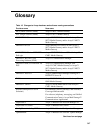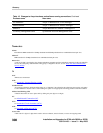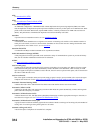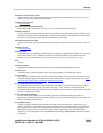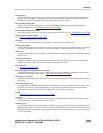
Glossary:
314
Installation and Upgrades for G700 with S8300 or S8700
555-234-100 — Issue 3 — May 2003
ATD
See
attention dial (ATD).
ATM
See
Asynchronous Transfer Mode (ATM).
ATM network duplication
An ATM-PNC configuration. A DEFINITY ECS without duplicated switch processing endpoints (SPEs) uses ATM
network duplication for duplicated expansion port network (EPN) connectivity to other points on an ATM network. These
points can be on the same ATM switch, separate ATM switches, or directly connected to an ATM wide area network
(WAN). The performance of ATM network duplication and critical reliability is the same.
attendant
A person who uses an attendant console. See also
attendant console.
attendant console
A workstation that an attendant uses to originate a call, answer an incoming call, transfer a call to another extension or
trunk, put a call on hold, or remove a call from hold. Attendants can also use the console to manage and monitor some
system operations. Also called console. See also
attendant.
attention dial (ATD)
A command in the Hayes modem command set for asynchronous modems.
Audio Information Exchange (AUDIX)
A fully integrated voice-mail system that can be used with a variety of communications systems to provide call-history
data, such as subscriber identification and reason for redirection.
AUDIX
See Audio Information Exchange (AUDIX).
auto-in trunk group
A trunk group for which the central office (CO) processes all the digits for an incoming call. When a CO seizes a trunk
from an auto-in trunk group, the switch automatically connects the trunk to the destination, which is usually an ACD
split. If no agents in the split are available to answer the call, the call is sent to a queue. In the queue, calls are answered in
the order in which the calls arrive.
auto-in work mode
One of four agent work modes. In the auto-in work mode, an agent is ready to process another call as soon as the agent
completes the current call. See also
after-call work (ACW) mode; aux work mode; manual-in work mode.
Automatic Alternate Routing (AAR)
A feature that routes calls to other than the first-choice route when the first-choice route is unavailable.
Automatic Callback (ACB)
A feature for internal callers who reach a busy extension. With ACB, the system automatically connects and rings both
parties when the called party is available.
Automatic Call Distribution (ACD)
A feature that answers calls, and then follows administered instructions to deliver appropriate messages to the caller, or
route the call to an agent. See also
Uniform Call Distribution (UCD).
Automatic Call Distribution (ACD) split
A group of extensions that are staffed by agents who are trained to handle a certain type of incoming call, and a method of
routing calls of a certain type among those agents in a call center.
automatic calling unit (ACU)
A device that places a telephone call on behalf of a computer.




